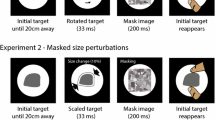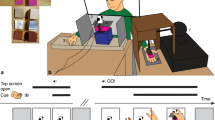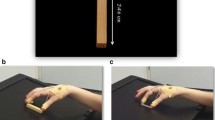Abstract
When picking up objects, we tend to grasp at contact points that minimize slippage and torsion, which depend on the particular shape. Normally, grasp points could be planned before initiating movement. We tested whether grasp points can be determined during online control. Subjects reached to grasp virtual planar objects with varied shapes. On some trials, the object was changed during movement, either rotated by 45° or replaced with a different object. In all conditions, grasp axes were well adapted to the target shape, passing near the center of mass with low force closure angles. On perturbed trials, corrective adjustments were detectable within 320 ms and were toward the same grasp axes observed on unperturbed trials. Perturbations had little effect on either kinematics or the optimality of final grasp points. Our results demonstrate that the visuomotor system is capable of online processing of shape information to determine appropriate contact points for grasping.









Similar content being viewed by others
References
Ansuini C, Santello M, Tubaldi F, Massaccesi S, Castiello U (2007) Control of hand shaping in response to object shape perturbation. Exp Brain Res 180(1):85–96
Bingham GP, Muchisky MM (1993a) Center of mass perception and inertial frames of reference. Percept Psychophys 54(5):617–632
Bingham GP, Muchisky MM (1993b) Center of mass perception: perturbation of symmetry. Percept Psychophys 54(5):633–639
Blake A, Brady J (1992) Computational modelling of hand-eye coordination [and discussion]. Philos Trans R Soc Lond B Biol Sci 337(1281):351–360
Bridgeman B, Lewis S, Heit G, Nagle M (1979) Relation between cognitive and motor-oriented systems of visual position perception. J Exp Psychol Hum Percept Perform 5(4):692
Cui L, Wang Y, Wang H, Tian S, Kong J (2000) Human brain sub-systems for discrimination of visual shapes. NeuroReport 11(11):2415–2418
Desmurget M, Prablanc C (1997) Postural control of three-dimensional prehension movements. J Neurophysiol 77(1):452–464
Doniger GM, Foxe JJ, Murray MM, Higgins BA, Snodgrass JG, Schroeder CE, Javitt DC (2000) Activation timecourse of ventral visual stream object-recognition areas: high density electrical mapping of perceptual closure processes. J Cogn Neurosci 12(4):615–621
Eloka O, Franz VH (2011) Effects of object shape on the visual guidance of action. Vision Res 51(8):925–931
Fan J, He J, Tillery SIH (2006) Control of hand orientation and arm movement during reach and grasp. Exp Brain Res 171(3):283–296
Gentilucci M, Chieffi S, Scarpa M, Castiello U (1992) Temporal coupling between transport and grasp components during prehension movements: effects of visual perturbation. Behav Brain Res 47:71–82
Glover S, Miall RC, Rushworth MF (2005) Parietal rTMS disrupts the initiation but not the execution of on-line adjustments to a perturbation of object size. J Cogn Neurosci 17(1):124–136
Goodale MA, Milner AD, Jakobson LS, Carey DP (1991) A neurological dissociation between perceiving objects and grasping them. Nature 349:154–156
Goodale MA, Meenan JP, Bülthoff HH, Nicolle DA, Murphy KJ, Racicot CI (1994a) Separate neural pathways for the visual analysis of object shape in perception and prehension. Curr Biol 4(7):604–610
Goodale MA, Jakobson LS, Keillor JM (1994b) Differences in the visual control of pantomimed and natural grasping movements. Neuropsychologia 32(10):1159–1178
Greenwald HS, Knill DC (2009) A comparison of visuomotor cue integration strategies for object placement and prehension. Vis Neurosci 26:63–72
Greenwald HS, Knill DC, Saunders JA (2005) Integrating visual cues for motor control: a matter of time. Vision Res 45(15):1975–1989. doi:10.1016/j.visres.2005.01.025
Hesse C, Franz VH (2009) Corrective processes in grasping after perturbations of object size. J Mot Behav 41(3):253–273
Kamp CVD, Bongers RM, Zaal FT (2009) Effects of changing object size during prehension. J Mot Behav 41(5):427–435
Karok S, Newport R (2010) The continuous updating of grasp in response to dynamic changes in object size, hand size and distractor proximity. Neuropsychology 48:3891–3900
Kleinholdermann U, Franz VH, Gegenfurtner KR (2013) Human grasp point selection. J Vis. doi:10.1167/13.8.23
Laimgruber K, Goldenberg G, Hermsdörfer J (2005) Manual and hemispheric asymmetries in the execution of actual and pantomimed prehension. Neuropsychologia 43(5):682–692
Landsmeer JMF (1962) Power grip and precision handling. Ann Rheum Dis 21(2):164
Lederman SJ, Wing AM (2003) Perceptual judgement, grasp point selection and object symmetry. Exp Brain Res 152(2):156–165
Mamassian P (1997) Prehension of objects oriented in three-dimensional space. Exp Brain Res 114:235–245
Milner AD, Goodale MA (1995) The visual brain in action. Oxford University Press, Oxford
Napier JR (1956) The prehensile movements of the human hand. J Bone Joint surg 38(4):902–913
Paulignan Y, MacKenzie CL, Marteniuk RG, Jeannerod M (1991a) Selective perturbation of visual input during prehension movements: the effects of changing object position. Exp Brain Res 83:502–512
Paulignan Y, MacKenzie C, Marteniuk R, Jeannerod M (1991b) Selective perturbation of visual input during prehension movements: II. The effects of changing object size. Exp Brain Res 83(3):502–512
Ponce J, Stam D, Faverjon B (1993) On computing two-finger force-closure grasps of curved 2D objects. Int J Robot Res 12(3):263–273
Sanz PJ, Del Pobil AP, Inesta JM, Recatala G (1998) Vision-guided grasping of unknown objects for service robots. In: Robotics and Automation, 1998. Proceedings of 1998 IEEE international conference on IEEE, vol 4, pp 3018–3025
Saunders JA, Knill DC (2003) Humans use continuous visual feedback from the hand to control fast reaching movements. Exp Brain Res 152(3):341–352. doi:10.1007/s00221-003-1525-2
Saunders JA, Knill DC (2004) Visual feedback control of hand movements. J Neurosci 24(13):3223–3234
Saunders JA, Knill DC (2005) Humans use continuous visual feedback from the hand to control both the direction and distance of pointing movements. Exp Brain Res 162(4):458–473. doi:10.1007/s00221-004-2064-1
Schettino A, Loeys T, Delplanque S, Pourtois G (2011) Brain dynamics of upstream perceptual processes leading to visual object recognition: a high density ERP topographic mapping study. Neuroimage 55(3):1227–1241
Seo NJ, Armstrong TJ (2009) Friction coefficients in a longitudinal direction between the finger pad and selected materials for different normal forces and curvatures. Ergonomics 52(5):609–616
Tunik E, Frey SH, Grafton ST (2005) Virtual lesions of the anterior intraparietal area disrupt goal-dependent on-line adjustments of grasp. Nat Neurosci 8(4):505–511
Voudouris D, Smeets JBJ, Brenner E (2013) Ultra-fast selection of grasping points. J Neurophysiol 110(7):1484–1489
Westwood DA, Chapman CD, Roy EA (2000) Pantomimed actions may be controlled by the ventral visual stream. Exp Brain Res 130(4):545–548
Westwood DA, Danckert J, Servos P, Goodale MA (2002) Grasping two-dimensional images and three-dimensional objects in visual-form agnosia. Exp Brain Res 144(2):262–267
Zhang R, Hu Z, Zebi R, Zhang L, Li H, Liu Q (2013) Neural processes underyling the “same”-“different” judgment of two simultaneously presented objects—an EEG study. PLoS One 8(32):e81737
Author information
Authors and Affiliations
Corresponding author
Rights and permissions
About this article
Cite this article
Chen, Z., Saunders, J.A. Online processing of shape information for control of grasping. Exp Brain Res 233, 3109–3124 (2015). https://doi.org/10.1007/s00221-015-4380-z
Received:
Accepted:
Published:
Issue Date:
DOI: https://doi.org/10.1007/s00221-015-4380-z




